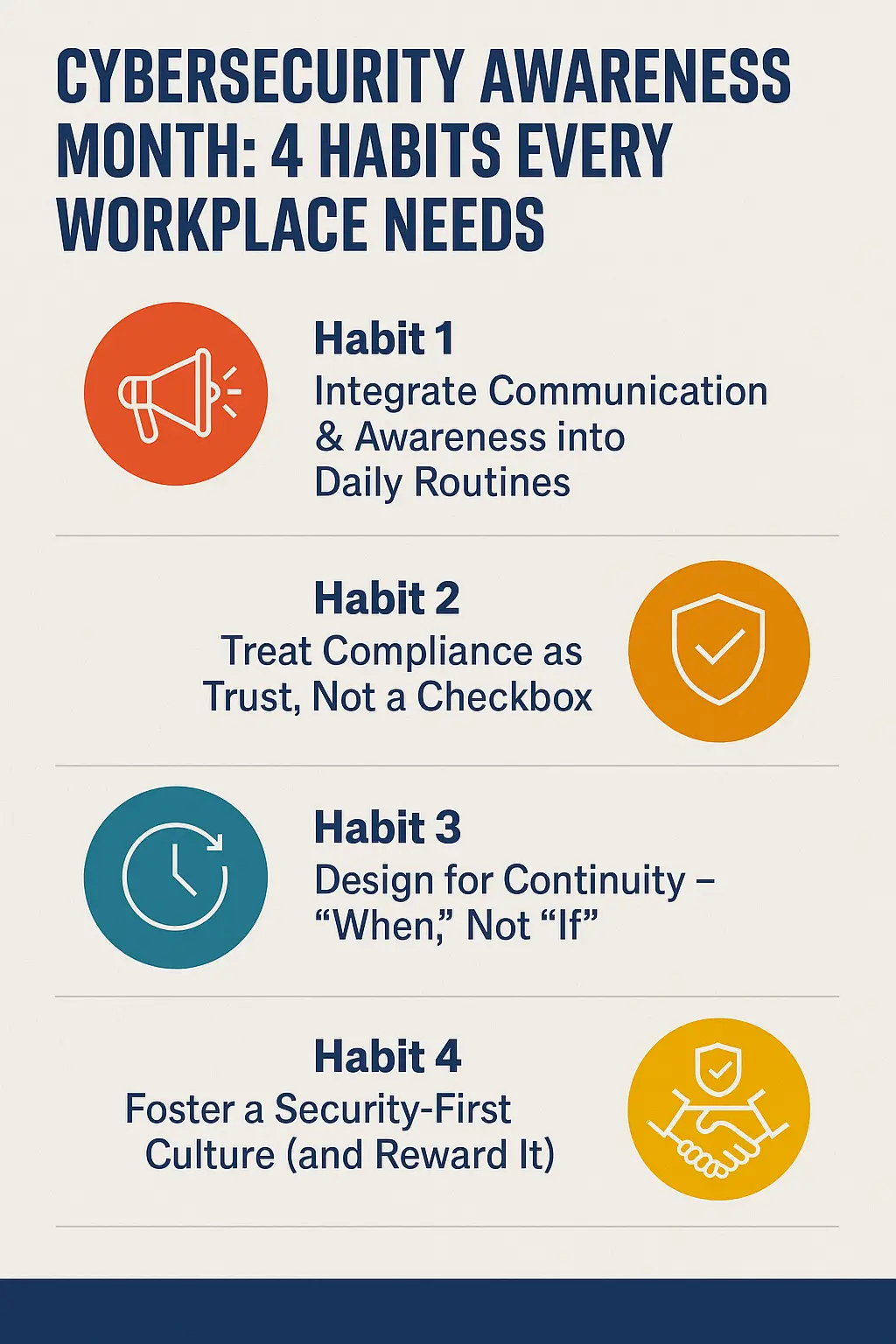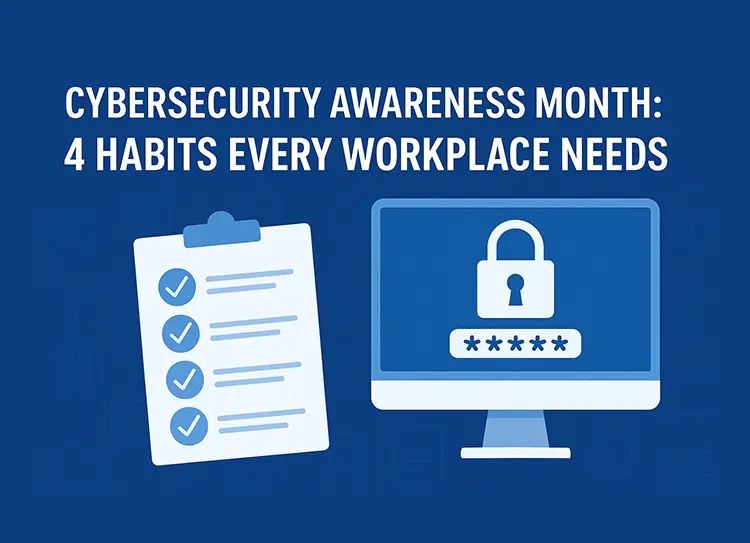Cybersecurity Awareness Month: 4 Habits Every Workplace Needs
“Security is not a product, but a process.” — Bruce Schneier
Every October, organizations across the U.S. pause to observe National Cybersecurity Awareness Month (NCSAM). First launched in 2004 by the U.S. Department of Homeland Security and the National Cyber Security Alliance, this initiative heightens public and business focus on digital safety.
For workplaces in North Carolina—whether in the Research Triangle, Charlotte’s banking hubs, or smaller towns like Asheboro or Wilmington—the stakes are high. The digital threats your organization faces are as real as those facing large national firms. That’s why adopting strong cybersecurity habits is more than compliance; it’s about resilience, trust, and continuity.
In this post, I’ll cover four foundational habits every workplace should adopt. These form a practical, culture-driven backbone for security. Along the way, I’ll embed examples, analogies, and regional context to make them tangible.

Why Habits Matter More Than Tools
You might wonder: “We already have firewalls, antivirus, backups, and even an IT team in place. Why push habits?” The answer: technology is necessary, but not sufficient. Many breaches trace back to human behavior—clicking the wrong link, using weak passwords, bypassing company rules.
Think of it this way: you could install the best lock system on your front door, but if someone leaves the key under the welcome mat, it’s futile. Cybersecurity tools are that lock; habits are how you ensure the key isn’t misused.
Moreover, habits cascade: when security becomes part of daily rhythm, people act more intuitively. Over time, the overhead of “remembering” security steps drops, and better behavior becomes default.
Habit 1: Integrate Communication & Awareness into Daily Routines
Why it matters
Security shouldn’t be siloed in IT or leadership meetings—it must permeate everyday operations. Frequent, bite-sized messaging reinforces awareness and keeps threats top of mind. Entech, in its guidance, calls this “put security in the daily conversation.”
How to embed it
- 60-second “phish check” at each meeting: Start weekly team huddles with a real (redacted) phishing email and ask staff, “What would you click?” Use this to stimulate short discussion.
- Regular threat alerts: Send a weekly “Threat Watch” with one short tip (e.g., “Watch out for domain typos,” or “Don’t trust links asking for login via email”).
- Single reporting channel: Make it crystal clear how and where to report suspicious activity.
- Visual cues: Post security posters near printers, break rooms, or in digital dashboards. Rotate them weekly so they don’t become wallpaper.
Example from NC context: A medium-sized firm in Charlotte instituted a “Security Tip Tuesday” email. Initially, engagement was low, but by tying small gift cards to staff who responded with good feedback or questions, participation climbed. Over three months, their phishing click-rate dropped by nearly 25%.
Habit 2: Treat Compliance as Trust, Not a Checkbox
Why it matters
Many businesses regard compliance—HIPAA, PCI, state privacy laws—as paperwork to satisfy regulators. But in reality, compliance is a shorthand for trustworthiness. Clients, partners, and even prospective customers expect data to be handled carefully.
The links you provided often underscore this: compliance is not only about fines but reputation.
How to shift the mindset
- Map requirements to behavior: Don’t just keep a binder of rules. Translate each compliance edict into operational habits (e.g., quarterly access audit, mandatory training, documented patching).
- Assign “owners”: For every domain—email, data retention, endpoint security—assign someone responsible. Let them report monthly status.
- Keep logs, not just documents: For audits, a record of when you ran updates, who changed permissions, or how backups were tested is gold.
- Engage a vCIO or consultant: If your internal team is small, a virtual CIO can help align compliance with business goals rather than simply adding red tape. Entech advises this tactic.
A regional analogy: North Carolina’s State IT apparatus (NCDIT) provides shared cybersecurity and hosting services to state agencies. Their requirement for secure network hosting and compliance with state standards shows how state-level compliance feeds into trust with citizens.
Habit 3: Design for Continuity—“When,” Not “If”
Why it matters
No system is invulnerable. It’s not a matter of if you experience an incident—it’s when. What matters is how quickly you can respond, recover, and resume operations.
Entech’s habit list calls this “continuity”—with emphasis on recovery rehearsal and clear recovery metrics.
How to build continuity
- Backup strategy (3-2-1 rule): Three copies of data, stored on two different media, with one offsite or immutable.
- Test restores monthly/quarterly: It’s not enough just to back up; you must practice restoring files (monthly) and full recovery (quarterly).
- Define clear RTO and RPO goals: Talk plainly—“How fast should systems be back up?” (RTO) and “How much data loss is tolerable?” (RPO).
- Maintain an incident runbook: A printed, secure version listing contacts, steps, credentials, and escalation paths.
- Tabletop exercises: Run 30-minute “what if” scenarios each quarter (e.g., ransomware, phishing leading to credential compromise) to see how staff respond.
Example: A Raleigh based nonprofit once attempted a full restore but realized their backup media had been corrupted. Because they hadn’t tested ahead, they lost 48 hours of operations. After adding a biannual full restore exercise, the next test succeeded in under an hour—saving tens of thousands in risk.
Habit 4: Foster a Security-First Culture (and Reward It)
Why it matters
Your employees are your de facto frontline defenders. No firewall can intercept every malicious email. Culture shapes how your team behaves when the system alarms. If security is seen as “IT’s job,” your defenses weaken.
Several of the top ranking posts emphasize this “culture” habit as critical.
How to build it
- Mandate MFA everywhere possible (especially critical systems).
- Deploy a company-wide password manager. Encourage passphrases and discourage reuse.
- Publicly celebrate security wins: e.g. “Jane reported a phishing email!” or “IT catch — flawed link aborted.” A “Security Wall of Fame” is a simple but effective idea.
- Gamify awareness: Quizzes, team challenges, bingo cards of security actions (e.g. “Enable MFA,” “Report suspicious link,” “Lock your screen”) encourage engagement.
- Visible leadership support: When executives share their own mistakes or reinforcement of the program, it signals priority.
Analogy: Think of culture like gravity. You don’t see it directly, but everything falls toward it. If culture “gravitates” toward laxness, people will cut corners. If culture gravitates toward vigilance, security actions feel natural.
Bringing all Four Habits Together: A Story from the Field
Let me share a hypothetical but realistic scenario, inspired by many real incidents:
A midsize logistics firm in Greensboro had strong firewalls, endpoint protection, and backup systems—but little staff awareness. One morning, someone in accounting clicked a link in an email that looked like a vendor invoice. It unleashed ransomware, which spread before the security team could fully stem it.
Because they lacked a tested restore process, they lost 36 hours of operations. Because staff had few habits around reporting suspicious messages, the breach stayed too long undetected. The financial damage could have been far worse.
Six months later, after engaging a local NC MSP (managed IT & security provider), they implemented our four habits:
- Daily awareness prompts in meetings
- Compliance routines and auditing tied to trust with carriers
- Regular full recovery drills and defined RTO/RPOs
- Recognition of staff “phish catchers”, mandatory MFA, usage of password vault
When a new spear-phishing email arrived just months later, an employee flagged it immediately. The IT team isolated the thread, prevented escalation, and avoided breach.
In short: preventive behaviors let their technical safeguards shine.
Sustaining These Habits Year-Round
October may be the kickstarter, but cyberthreats live year-round. Here are strategies to keep momentum:
- Monthly “security retrospectives”: Brief check-ins: What near-miss happened? What went well? What should we emphasize next month?
- Microlearning modules: Short (2–5 minute) training videos or quizzes distributed weekly—not just in October.
- Quarterly refreshes of posters and tips: Renew messaging visuals to avoid complacency.
- Incident after-action reporting: Even low-level incidents should be reviewed and documented.
- Link security to business goals: Show how investments in security reduce risk, legal exposure, and downtime costs.
- Budget cycles: In your annual IT planning, bake in funding for awareness tools, training, continuity exercises, and enhancements.
Specific Considerations for North Carolina Workplaces
Because you asked for regional relevance, here are some North Carolina–specific aspects to keep in mind:
- Local IT & cybersecurity services
North Carolina hosts a strong ecosystem of cybersecurity service providers, including firms like Computerbilities. If your organization lacks internal capacity, a regional MSP or MSSP (Managed Security Services Provider) can help operationalize these habits. - Compliance & state regulations
Some sectors in NC—education, healthcare, government contracting—have compliance mandates (e.g., HIPAA, FERPA, state data laws). Ensuring your habits align with those local and federal regulations is essential. - NC government IT practices
The North Carolina Department of Information Technology (NCDIT) offers infrastructure, cybersecurity, and hosting services to state agencies. Their standards can sometimes serve as benchmarks for best practices in the region. - Talent pool & cybersecurity awareness scale
Research Triangle and Charlotte are hubs for cybersecurity hiring. For example, demand is projected to surge by 2026. That means local firms can access skilled resources to help operationalize these habits. - Shared regional awareness campaigns
Consider collaborating with local chambers, business associations, or universities (e.g., NC State, UNC, UNC Charlotte) to run joint cybersecurity awareness events. This not only amplifies reach but also fosters community resilience.
Sample 12-Month Implementation Roadmap
Period | Focus | Key Activities |
October | Launch & Awareness | Kick off with daily tips, posters, table-top drills, phishing simulations |
Nov–Dec | Reinforcement | Continue weekly tips, plug residual gaps, run mini simulations |
Q1 (Jan–Mar) | Expand | Add microlearning modules, deeper departmental drills, recognition programs |
Q2 (Apr–Jun) | Audit & Adjust | Review metrics (phish click rate, reporting), run full restore tests |
Q3 (Jul–Sep) | Renew & Refresh | New visuals, scenario planning, leadership reaffirmation |
Next Oct | Relaunch | Build on successes, share results, expand to partners/vendors |
Metrics you can track: phishing click rate, number of reported suspicious messages, restore times, staff training completion rates, incident counts.
Conclusion
Cybersecurity isn’t a checkbox or seasonal effort—it’s sustained vigilance built on consistent habits. During Cybersecurity Awareness Month, your organization can take meaningful strides by embedding the four key habits:
- Daily communication & awareness
- Compliance tied to trust, not paperwork
- Continuity planning and rehearsal
- Security-first culture with rewards
In North Carolina, you have an advantage: access to local IT support firms, regional compliance norms, and a tech talent pipeline. Pair those strengths with these habits, and you elevate your organization’s resilience.

